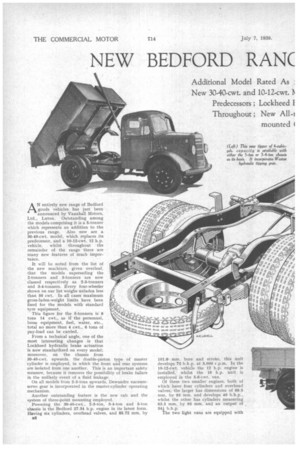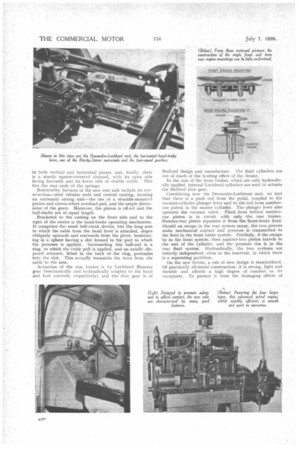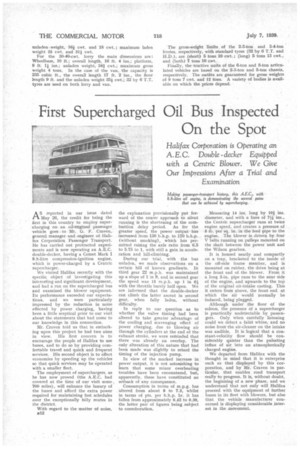NEW BEDFORD RAN( OF WIDENED SCOPE
Page 42

Page 43

Page 44

Page 45

Page 46

If you've noticed an error in this article please click here to report it so we can fix it.
AN entirely new range of Bedford goods vehicles has just been announced by Vauxhall Motors, Ltd., Luton. Outstanding among the models comprising it is a 5-tonner which represents an addition to the previous range. Also new are a 30-40-cwt. model, which replaces its predecessor, and a 10-12-cwt. 12 h.p. vehicle, whilst throughout the remainder of the range there are many new features of much importance.
It will be noted from the list of the new machines, given overleaf, that the models superseding the 2-tonners and 3-tonners are now classed respectively as 2-3-tonners and 3-4-tonners. Every four-wheeler shown on our list weighs unladen less than 50 cwt. In all cases maximum gross-laden-weight limits have been fixed for the models with standard tyre equipment.
This figure for the 5-tonners is 8 tons 14 cwt., so if the personnel, loose equipment, fuel, water, etc., total no more than 4 cwt., 6 tons of pay-load can be carried.
From a technical angle, one of the most interesting changes is that Lockheed hydraulic brake actuation is now standardized on every model; moreover, on the chassis from 30-40-cwt. upwards. the double-piston type of master cylinder is employed, in which the front and rear systems are isolated from one another. This is an important safety measure, because it removes the possibility of brake failure in the unlikely event of a fluid leakage.
On all models from 2-3-tons upwards, Dewandre vacuumservo gear is incorporated in the master-cylinder operating mechanism.
Another outstanding feature is the new cab and the system of three-point mounting employed. Powering the 30-40-cwt., 2-3-ton, 9-4-ton and 5-ton chassis is the Bedford 27.34 h.p. engine in its latest form. Having six cylinders, overhead valves, and 85,72 mm. by a8 101.6. mm. bore and stroke, this unit develops 72 b.h.p. at 3,000 r.p.m. In the 10-12-cwt. vehicle the 12 h.p. engine is installed, whilst the 10 h.p. unit is employed in the 5-6-cwt. van.
Of these two smaller engines, both of which have four cylinders and overhead valves, the larger has dimensions of 69.5 mm. by 95 mm. and develops 40 b.h.p., whilst the other has cylinders measuring 63.5 mm. by 95 mm. and an output of 341 b.h.p, The two light vans are equipped with
three-speed gearboxes, whilst four speeds are available on the four medium-weight types.
In view of the fact that the new 5-tonner will be the most interesting of the range to the larger number of operators, we propose to give priority to a description of this, but most of the features are common to its confreres. The two wheelbase lengths in which it is available are 9 ft. 3 ins. and 13 ft. 1 in, respectively, and the overall lengths are 15 ft. 6 ins. and 21 ft. 4 ins. These dimensions permit body lengths of 8 ft, l ins. and 14 ft. in the respective cases. All these" figures are the same as for the 3-4-tonner.
The chassis weights are 35,1 cwt. and 37i cwt.--slightly heavier than the next smaller machine. As tyres are an important factor in weight and carrying capacities, we give particulars of these next. On the front wheels, 32 by 6 II.D. equipment is used, whilst the rear wheels are shod with 34 by 7 twins, and this is the size of the spare.
Besides the vehicle types named in the accompanying panel, a large variety of others is available, notably pantechnicons, cattle trucks and municipal machines. This applies to the whole range excepting the two smallest models.
A feature of the tipping model is that it incorporates a Weston four-cylindered pump. This is of the self-priming type and is operated from the driver's seat. The tipping angle is 50 degrees and the body, which is built of hard wood with metal-lined floor, complies with the Sand and Ballast Regulations. In this connection, the capacity of the 3-4-ton end-tipper has been increased to 4 cubic yds.
As can be seen from our drawing of the long 5-tanner, the frame is a strongly constructed unit which represents no useless weight. The side members have a maximurn section of 8 ins. by 3 ins. by 7-32 in., they are kicked up slightly over the rear axle, and are braced by six crossmembers. The foremost of these is a big shaped inverted channel, widened at the centre and carrying the front engine rubber mounting and the radiator. Supporting the back of the unit, by two rubber-insulated brackets, is a dropped inverted "hat "-section member.
To take, at its centre. the rear cab mounting a further slightly raised, inverted hat" member is used. It has a wide " brim " at its ends for anchorage to the longitudinals. This member also carries the hand-brake lever, which is of bell-crank shape, the grip end lying practically horizontal. On the complete vehicle the lever is between the seats, where it constitutes no obstruction and is convenient for a strong pull.
A straight member of similar section comes next and attached to its under side is the centre bearing of the Hardy Spicer two-piece propeller shaft. Lining up with the rearspring forward brackets is a shallow channel, well-gusseted in both vertical and horizontal planes, and, finally, there is a sturdy square-cornered channel, with its open side facing forwards and its lower side of double width, This ties the rear ends of the springs.
Noteworthy features of the new rear axle include its construction—steel tubular ends and central casting, forming an extremely strong unit—the use of a straddle-mounted pinion and crow-n-wheel overload pad, and the ample dimensions of the gears. Moreover, the pinion is off-set and the half-shafts are of equal length.
Bracketed to the casting on the front side and to the right of the centre is the hand-brake operating mechanism. It comprises the usual bell-crank device, but the long arm to which the cable from the hand lever is attached, slopes obliquely upwards and rearwards from the pivot, terminating in a sphere having a slot formed in the part to which the pressure is applied. Surrounding this ball-end is a ring, to which the cable pull is applied, and an axially disposed setscrew, fitted in the back of the ring. protrudes into the slot. This actually transmits the force from the cable to the arm.
Actuation of the rear brakes is by Lockheed Bisector gear (mechanically and hydraulically coupled to the hand and foot controls, respectively) and the shoe gear is of Bedford design and manufacture. The fluid cylinders are Out of reach of the heating effect of the drums.
In the case of the front brakes, which are only hydraulically applied, internal Lockheed cylinders are used to actuate the Bedford shoe gear.
Considering now the Dewandre-Lockheed unit, we find that there is a push rod from the pedal, coupled to the vacuum-cylinder plunger lever and to the rod from numberone piston in the master cylinder. The plunger lever also operates the vacuum valve. Fluid from behind numberone piston is in circuit with only the rear brakes. Number-two piston separates it from the front-brake fluid. Should an escape in the rear system occur, the two pistons make mechanical contact and pressure is transmitted to the fluid in the front brake system. Similarly, if the escape be in the front system, then number-two piston travels to the end of the cylinder, and the pressure rise is in the rear fluid system. Hydraulically, the two systems are entirely independent, even, to the reservoir, in which there is a separating partition.
On the new lorries, a cab of new design is standardized. Of practically all-metal construction, it is strong, light and durable and affords a high degree of comfort to its occupants. To protect it from the damaging effects of frarne distortion, the cab, which incorporates it.s own steel frame, is mounted at three points, the well-designed fixings being provided with non-ageing rubber cushions, which insulate it from vibration and afford the necessary elasticity.
To promote safety, measures have been adopted to give the driver the best possible outlook. Between the windscreen pillars the angle of vision is actually over 90 degrees, whilst the pillars themselves are notably slender. Both doors are equipped with balanced windows, which can be raised or lowered with little effort, and a practical point is that there are no internal door handles, the catches being actuated by small handles protruding above tile uindow Ventilation is afforded by fitments in the scuttle, the toe-well panels are lined with heat-resisting material and there is a lining to the roof with an intermediate air space. This maintains a constancy of temperature besides promoting silence. To give access to the rear of the engine, the panels on each side of the housing within the cab are detachable.
Another important maintenance detail is that the backs of the instruments and switches can readily be reached
under the scuttle from the front. Scientific design is reflected even in the comfort of the upholstery and a draught-excluder is provided around the hand-brake fever.
Improvements to the Bedford engine haire, in the main, been confined to detail refinements, and practically all the well-known features have been retained. Mention may well be made of the latest rubber mountings, of the tapering-section combustion chamber, giving steady burning of the mixture, of the " six-phase " carburetter, which automatically varies the fuel-air ratio to suit conditions, in a manner consistent with economy and power, and of the thermostatic control of induction and cooling-water temperatures.
Important parts in efficient and smooth running are also played by the double automatic ignition control, the individually cast piston rings, the flood lubrication of the piston and the integrally counterweighted crankshaft.
Clutches on all models are of adequate size and incor porate spring centres. The gearboxes are good examples Of sturdy construction, having short, sturdy shafts, wide pinions and bearings capable of standing up to heavy duty.
Among other noteworthy general features may be named the reverse camber progressive rear springs, which embody additional helper springs, the worm-and-wheel steering gear and the Thompson self-adjusting joints in the linkage.
Briefly to consider now the two light vans, the 10-12cwt. model is new and takes the place of the former 8-cwt.
van. It affords 110 cubic ft. of loading space, plus 10 cubic it. beside the driver, and its price, 4160, is attractively low. In the case of the 5-0-cwt. vehicle, the capacity is 70 cubic it.
Both these machines are of considerable technical interest because of the torsion-bar suspension systems employed at the front. Differences from the other models in the new range, in addition to those already mentioned, include Burman-Douglas screw-and-nut steering and semi-floating, instead of fully floating, axles. The gearboxes have synchromesh top and second ratios.
The following dimensions, arranged respectively, apply to the 5-6-cwt. and 10-12-cwt. models:—Wheelbase, 7 ft. 10 ins. and 8 ft. 9 ins., overall length, 13 ft. and 14 ft. 8 ins., platform length, 5 ft. 5* ins. and 6 ft. 6 ins., unladen weight, 164cwt. and 18 cwt.; maximum laden weight 25 cwt. and 31i cwt.
For the 30-40-cwt. lorry the main dimensions are : Wheelbase, 10 ft.; overall length, 16 ft. 4 ins.; platform, 8 ft. 11 ins.; unladen weight, 341 cwt.; maximum gross weight 4 tons, In the case of the van, the capacity is 235 cubic ft., the overall length 17 ft. 2 ins., the floor length 9 ft. and the unladen weight 35f cwt.; 32 by 6 T.T. tyres are used on both lorry and van.
The gross-weight limits of the 2-3-ton and 3-4-ton lorries, respectively, with standard tyres (32 by 6 T.T. and are (short) 5 tons 10 cwt.; (long) 5 tons 13 cwt., and (both) 7 tons 10 cwt.
Finally, the tractive units of the 6-ton and 8-ton articulated vehicles are based on the 2-3-ton and 5-ton chassis, respectively. The outfits are guaranteed for gross weights of 9 tons 7 cwt. and 12 tons. A variety of bodies is available on which the prices depend.




















































































